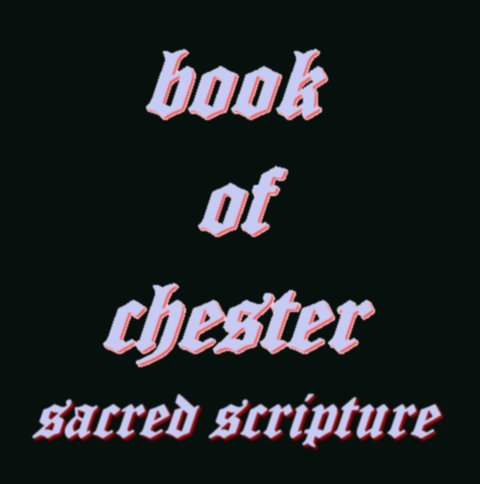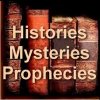
Introduction
Preface Second Ed.
Preface Third Ed.
Note by the Editor
The Two Systems
Trinity in Unity
Mother and Child
The Child in Assyria
The Child in Egypt
The Child in Greece
Death of the Child
Deification of the Child
Mother of the Child
Christmas
Easter
Nativity of John
Feast of thr Assumption
Baptismal Regeneration
Justification by Works
Sacrifice of the Mass
Extreme Unction
Purgatory and Prayers for the Dead.
Idol Processions
Relic Worship.
Clothing and Crowning of Images.
The Rosary
Lamps & Wax-candles
Sign of the Cross
Sovereign Pontiff
Priests, Monks, and Nuns.
Great Red Dragon
Beast From the Sea
Beast from the Earth
Image of the Beast
Number of the Beast
Invisible Head of the Papacy
Woman with Golden Cup
Hebrew Chronology
Shing Moo and Ma Tsoopo of China.
Ala-Mahozim
Meaning of the name Centaurus
Olenos, the Sin-Bearer
Identification of Rhea or Cybele and Venus
Virgin Mother of Paganism
Goddess Mother as a Habitation.
Meaning of the name Astarte.
Oannes and Souro
The Identity of the Scandinavian Odin and Adon of Babylon
Stripping of the Clothes of the Initiated in the Mysteries
Zoroaster, the Head of the Fire-Worshippers
Story of Phaethon
Roman Imperial Standard of the Dragon of Symbol of Fire-worship
The Slaying of the Witness
Attes, the Sinner
Click here for The Reluctant Messenger (Host Site)
APPENDIX - Zoroaster, the Head of the Fire-Worshippers.
NOTE N, p.228.
Zoroaster, the Head of the Fire-Worshippers.
That Zoroaster was head of the fire-worshippers, the following, among other evidence, may prove. Not to mention that the name Zoroaster is almost a synonym for a fire-worshipper, the testimony of Plutarch is of weight: "Plutarchus agnoscit Zoroastrem apud Chaldaeos Magos instituisse, ad quorum imitationem Persae etiam sus habuerunt. * Arabica quoque Historia (ab Erpenio edita) tradit Zaradussit non primum instituisse. sed reformasse religionem Persarum et Magorum, qui divisi erant in plures sectas" (Clericus, lib. i. De Chaldaeis, sect. i. cap. 2, vol. ii. p. 195); "Plutarch acknowledges that Zoroaster among the Chaldeans instituted the Magi, in imitation of whom the Persians also had their (Magi). The Arabian History also (edited by Erpenius) relates that Zaradussit, or Zerdusht, did not for the first time institute, but (only) reform the religion of the Persians and Magi, who had been divided into many sects." The testimony of Agathias is to the same effect. He gives it as his opinion that the worship of fire came from the Chaldeans to the Persians, lib. ii. cap. 25, pp. 118, 119. That the Magi among the Persians were the guardians of "the sacred and eternal fire" may be assumed from Curtius (lib. iii. cap.3, pp. 41, 42), who says that fire was carried before them "on silver altars; from the statement of Strabo (Geograph., lib. xv. p. 696), that "the Magi kept upon the altar a quantity of ashes and an immortal fire," and of Herodotus (lib. i. p. 63), that "without them, no sacrifice could be offered." The fire-worship was an essential part of the system of the Persian Magi (WILSON, Parsee Religion, pp. 228-235). This fire-worship the Persian Magi did not pretend to have invented; but their popular story carried the origin of it up to the days of Hoshang, the father of Tahmurs, who founded Babylon (WILSON, pp. 202, 203, and 579)---i.e., the time of Nimrod. In confirmation of this, we have seen that a fragment of Apollodorus (Muller, 68) makes Ninus the head of the fire-worshippers. Layard, quoting this fragment, supposes Ninus to be different from Zoroaster (Nineveh and its Remains, vol. ii. p. 443, Note); but it can be proved, that though many others bore the name of Zoraster, the lines of evidence all converge, so as to demonstrate that Ninus and Nimrod and Zoroaster were one. The legends of Zoroaster show that he was known not only as a Magus, but as a Warrior (ARNOBIUS, lib. i. p. 327). Plato says that Eros Armenius (whom CLERICUS, De Chaldaeis, states, vol. ii. p. 195, to have been the same as the fourth Zoroaster) died and rose again after ten days, having been killed battle; and that what he pretended to have learned in Hades, he communicated to men in his new life (PLATO, De Republica, lib x. vol. ii. p.614). We have seen the death of Nimrod, the original Zoroaster, was not that of a warrior slain in battle; but yet this legend of the warrior Zoroaster is entirely in favour of the supposition that the original Zoroaster, the original Head of the Magi, was not a priest merely, but a warrior-king. Everywhere are the Zoroastrians, or fire-worshippers, called Guebres or Gabrs. Now, Gen. x. 8 proves that Nimrod was the first of the "Gabrs."
As Zoroaster was head of the fire-worshippers, so Tammuz was evidently the same. We have seen evidence already that sufficiently proves the identity of Tammuz and Nimrod; but a few words may still more decisively prove it, and cast further light on the primitive fire-worship. 1. In the first place, Tammuz and Adonis are proved to be the same divinity. Jerome, who lived in Palestine when the rites of Tammuz were observed, up to the very time when he wrote, expressly identifies Tammuz and Adonis (vol. ii. p.353), in his Commentary on Ezekiel, viii. 14, where the Jewish women are represented as weeping for Tammuz; and the testimony of Jerome on this subject is universally admitted. Then the mode in which the rites of Tammuz or Adonis were celebrated in Syria was essentially the same as the rites of Osiris. The statement of Lucian (De Dea Syria, vol. iii. p. 454) strikingly shows this, and Bunsen (vol. i. p. 443) distinctly admits it. The identity of Osiris and Nimrod has been largely proved in the body of this work. When, therefore, Tammuz or Adonis is identified with Osiris, the identification of Tammuz with Nimrod follows of course. And then this entirely agrees with the language of Bion, in his Lament for Adonis, where he represents Venus as going in a frenzy of grief, like a Bacchant, after the death of Adonis, through the woods and valleys, and"calling upon her Assyrian husband" (BION, Idyll, Id. i. v. 214, in Portae Minores Graeci, p. 304). It equally agrees with statement of Maimonides, that when Tammuz was put to death, the grand scene of weeping for that death was in the temple of Babylon(see ante, p. 62). 2. Now, if Tammuz was Nimrod, the examination of the meaning of the name confirms the connection of Nimrod with the first fire-worship. After what has already been advanced, there needs no argument to show that, as the Chaldeans were the first who introduced the name and power or kings (SYNCELLUS, vol. i. p. 169), and as Nimrod was unquestionably the first of these kings, and the first, consequently, that bore the title of Moloch, or king, so it was in honour of him that the "children were made to pass through the fire" was undoubtedly to purify. The name Tammuz has evidently reference to this, for it signifies "to perfect," that is, "to purify" * "by fire;" and if Nimrod was, as the Paschal Chronicle (vol. i. pp. 50, 51), and the general voice of antiquity, represent him to have been, the originator of fire-worship, this name very exactly expresses his character in that respect. It is evident, however, from the Zoroastrian verse, elsewhere quoted (ante, p. 245), that fire itself was worshipped as Tammuz, for it is called the "Father that perfected all things." In one respect this represented fire as the Creative god; but in another, there can be no doubt that it had reference to the "perfection" of men by "purifying" them. And especially it perfected those whom it consumed. This was the very idea that, from time immemorial until very recently, led so many widows in India to immolate themselves on the funeral piles of their husbands, the woman who thus burned herself being counted blessed, because she became Suttee * --i.e., "Pure by burning." And this also, no doubt, reconciled the parents who actually sacrificed their children to Moloch, to the cruel sacrifice, the belief being cherished that the fire that consumed them also "perfected" them, and made them meet for eternal happiness. As both the passing through the fire, and the burning in the fire, were essential rites in the worship of Moloch or Nimrod, this is an argument that Nimrod was Tammuz. As the priest and representative of the perfection or purifying by fire, and so he was called by its name.
When we turn to the legends of India, find evidence to the very same effect as that which we have seen with regard to Zoroaster and Tammuz as head of the fire-worshippers. The fifth head of Brahma, that was cut of for inflicting distress on the three worlds, by "effulgence of its dazzling beams, " referred to in the text of this work, identifies itself with Nimrod. The fact that that fifth head was represented as having read the Vedas, or sacred books produced by the other four heads, shows, I think, a succession. * Now, coming down from Noah, what would that succession be? We have evidence from Berosus, that, in the days of Belus--that is, Nimrod--the custom of making representations like that of two-headed Janus, had begun. * Assume, then, that Noah, as having lived in two worlds, has his two heads. Ham is the third, Cush the forth, and Nimrod is, of course, the fifth. And this fifth head was cut off for doing the very thing for which Nimrod actually was cut off. I suspect that this Indian myth is the key to open up the meaning of a statement of Plutarch, which, according to the terms of it, as it stands, is visibly absurd. It is as follows: Plutarch (in the forth book of his Symposiaca, Quaest. 5, vol. ii. p. 570, B) says that "the Egyptians were of the opinion that darkness was prior to light, and that the latter [viz., light] was produced from mice, in the fifth generation, at the time of the new moon." In India, we find that "a new moon" was produced in a different sense from the ordinary meaning of that term, and that the production of that new moon was not only important in Indian mythology, but evidently agreed in time with the period when the fifth head of Brahma scorched the world with its insufferable splendour. The account of its production runs thus: that the gods and mankind were entirely discontented with the moon which they gad got, "because it gave no light," and besides the plants were poor and the fruits of no use, and that therefore they churned the White sea [or, as it is commonly expressed, "they churned the ocean"], when all things were mingled--i.e., were thrown into confusion, and that then a new moon, with a new regent, was appointed, which brought in an entirely new system of things (Asiatic Researches, vol. ix. p. 98). From MAURICE'S Indian Antiquities (vol. ii. sect. 6, pp. 264-266), we learn that at this very time of the churning of the ocean, the earth was set on fire, and a great conflagration was the result. But the name of the moon in India is Soma, or Som (for the final a is only a breathing, and the word is found in the name of the famous temple of Somnaut, which name signifies "Lord of the Moon"), and the moon in India is male. As this transaction is symbolical, the question naturally arises, who could be meant by the moon, or regent of the moon, who was cast off in the fifth generation of the world? The name Some shows at once who he must have been. Some is just the name of Shem; for Shem's name comes from Shom, "to appoint," and is legitimately represented either by the name Som, or Sem, as it is in Greek; and it was precisely to get rid of Shem (either after his father's death, or when the infirmities of old age were coming upon him) as the great instructor of the world, that is, as the great diffuser of spiritual light, that in the fifth generation the world was thrown into confusion and the earth set on fire. The propriety of Shem's being compared to the moon will appear if we consider the way in which his father Noah was evidently symbolised. The head of a family is divinely compared to the sun, as in the dream of Joseph (Genesis xxxvii.9), and it may be easily conceived how Noah would, by his posterity in general, be looked up to as occupying the paramount place as the Sun of the world; and accordingly Bryant, Davies, Faber, and others, have agreed in recognising Noah as so symbolised by Paganism. When, however, his younger son--for Shem was younger than Japhet--(Genesis x. 21) was substituted for his father, to whom the world had looked up in comparison of the "greater light," Shem would naturally, especially by those who disliked him and rebelled against him, be compared to "the lesser light," or the moon. * Now, the production of light by mice at this period, comes in exactly to confirm this deduction. A mouse in Chaldee is "Aakbar"; and Gheber, or Kheber, in Arabic, Turkish, and some of the other eastern dialects, becomes "Akbar," as in the well-known Moslem saying, "Allar Akbar," "God is Great." So that the whole statement of Plutarch, when stripped of its nonsensical garb, just amounts to this, that light was produced by the nonsensical garb, just amounts to this, that light was produced by the Guebres or fire-worshippers, when Nimrod was set up in opposition to Shem, as the representative of Noah, and the great enlightener of the world.
Previous | Next
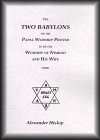
or The Papal Worship Proved to be the Worship of Nimrod and His Wife
$3.99 Kindle eBook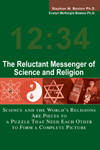
Buy from Amazon.com
The Essential Teachings of Herbert W. Armstrong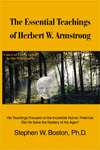
His Teachings Focused on The Incredible Human Potential. Did He Solve the Mystery of the Ages?
New Book about HWA's Teachings. Recommended!

